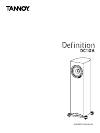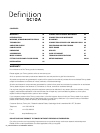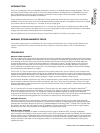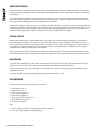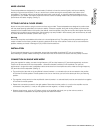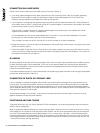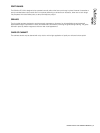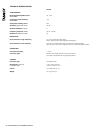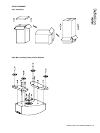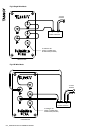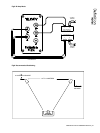
06_ DEFINITION DC10A OWNER’S MANUAL
CONNECTION IN BI-WIRE MODE
Please note in Bi-wire mode that the link cables should not be used. (See g. 4)
• If not using specially designed bi-wire cable, prepare the two sets of cabling for each ‘side’ of the system separately.
Measure and cut four lengths of cable, two per speaker. Label two of the cable lengths Left LF and Left HF (low
frequency and high frequency) then repeat this process for the right pair.
• If your amplier is not equipped with separate output terminals for bass and treble information then, at the amplier end
of the cables, twist the Left LF+ (positive) and the Left HF+ (positive) together. Connect these to the amplier Left channel
positive terminal marked + (plus) or coloured red.
Twist the Left LF- (negative) and the HF- (negative) cables together and connect them to the amplier Left channel
negative terminal marked - (minus) or coloured black.
At the loudspeaker end connect the cables labelled Left LF+ and Left LF- to the left hand loudspeaker LF terminals,
ensuring that you note the polarity markings on the cable sheathing.
Then proceed to connect the Left HF+ and Left HF- to the HF terminals on the same loudspeaker.
• Repeat this process to connect the right hand loudspeaker to the amplier right channel output, once again ensuring that
polarity is correct throughout.
• Switch the amplier on with the volume control set at its lowest setting. Select a favourite source and slowly turn up the
volume to a low level. Check that bass and treble information is being reproduced from both speakers - if not, switch off
the amplier and recheck the connections.
BI-AMPING
Bi-amping extends the principle of Bi-wiring one stage further. In this connection option separate power ampliers are used
for bass and treble signals in each loudspeaker. Four mono (or two stereo) ampliers of the same type are required for a
stereo pair of loudspeakers. Ensure that the cable links between the loudspeaker terminals are removed and that correct
polarity is maintained throughout.
If two stereo ampliers are used, it is recommended that one amplier supply bass information to left and right loudspeakers
and the other treble information. (See g. 5)
CONNECTION OF EARTH OR ‘GROUND’ LEAD
Use of a shielded or screened loudspeaker cable will offer further performance advantages when used with the ve-way
terminal panel. The screening termination should be connected to the earth or ground (white) terminal on the loudspeaker
and to the ground or earth connection on the amplier. Alternatively if you are not using a screened loudspeaker cable but
wish to utilise the earthing facility, run a single cable between the earth or ‘ground’ (white) terminal on the loudspeaker to the
earth (ground) connection on the amplier.
Avoid potential damage to your amplier - ensure that all connections are secure and the polarity is correct in all wiring.
(Method illustrated on all terminal panel sketches)
POSITIONING AND FINE-TUNING
To get best results from your new Tannoy Denition DC10A loudspeakers, it is worthwhile spending a little time nding the
optimum set-up conguration.
Begin by angling the speakers towards your chosen listening position, usually this is on the centre line of the room, so that
when seated you can just see the inner side panel of each speaker. The front of the loudspeaker should not be obstructed
in any way. The loudspeakers should be located between 1.5 to 4.5 metres (5ft to 15ft) apart - with the listening position
set slightly further away than the speakers are apart. Avoid positioning the loudspeakers in corners of the room, as this will
have a negative effect on performance. Ideally, maintain a distance of at least 0.5 metres (20 inches) from the rear wall, and
1 metre (39 inches) from the side. (See g. 6).



